






















































Bob Dylan was not the greatest enthusiast of sheet and tiller ever to grace the waters – far from it. What emerges from our article on his two boats, however, is a picture of a generous, easy-going soul happy to help out friends when costs spiralled out of their control. It rather goes against the general perception of him – my Dylan-obsessed friend (we’ve all got one), tells me he’s famously difficult; but boats and the sea always seem to bring out the best in people, as you know. You’ll note that there’s a nice little wooden runabout in this issue. The name of the maker might surprise you: Jeanneau. You’ll notice too that our cover this month features a glass boat. It’s not as shocking as the moment Dylan “went electric” perhaps, but it’s in a similar vein. Dylan followed up with some of his best work ever after he plugged in – including the Blood on the Tracks album. At least, this is what the Dylan-obsessed friend tells me: I wouldn’t have a clue. All I can tell you is that normal service – wooden yachts in other words – will resume soon.


COVER STORY
4 . GLASS CEILING





e Nic 55 that served in the army then went ocean racing, fresh from re t



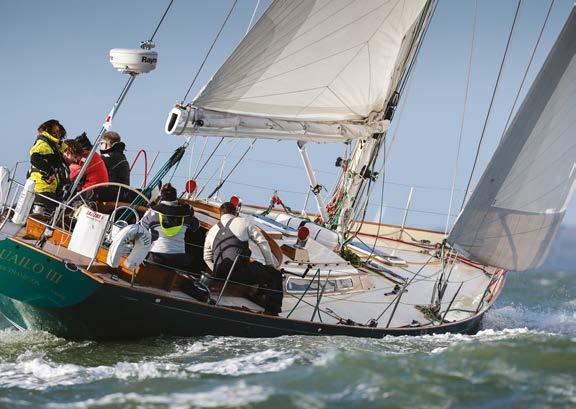
12 . OUT AND ABOUT
In Sydney for the Australia Day Regatta and Helsinki for the Classic Yacht


22 . WHO TAKES THE BEST PICS?


 WORDS NIGEL SHARP PHOTOS PAUL WYETH
WORDS NIGEL SHARP PHOTOS PAUL WYETH
In 1969, Lloyds Yacht Club approached Camper & Nicholsons with a view to commissioning a new yacht to replace Lutine, the Laurent Giles-designed yawl which the company had built in 1952. The result was the in-house designed GRP Nicholson 55, of which the new Lutine was the first of 26 sister ships which were built with various rigs and deck layouts over the next decade. The third of these was Quailo III which was built in 1971 for Donald Parr, who would later become commodore then admiral of the Royal Ocean Racing Club. Parr was a loyal client of Camper & Nicholsons – his first Quailo was a one-tonner that had been designed and built as Yeoman XIV by the company in 1966, and Quailo II was a 1969 Nicholson 43 – and, having done a lot of business in Hong Kong, had chosen the name for his three boats from a Chinese derogatory term for westerners.
Parr’s primary aim in Quailo III’s first season was to gain selection for the British three-boat Admiral’s Cup team. Competing against 26 other boats in the trials throughout May and early June, Quailo had some early successes, with Yachts & Yachting reporting partway through that she “laid a firm claim to being best of the big league.” However, the selectors decided that the best way to win the Admiral’s Cup was with a team of small boats with low ratings, and Quailo had to make do with being reserve boat. “That made us determined to prove the selectors wrong,” Peter Nicholson, principal helmsman on Quailo at the time, told me recently, “and we did so very successfully.” Those successes included winning the New York Yacht Club Cup in Cowes Week and coming second overall in both the Channel Race and the Fastnet Race, all of which were part of the Admiral’s Cup series.
Further minor successes came the following year, then in 1973 Quailo was, at last, selected for the British Admiral’s Cup team, along with Frigate and the third Morning Cloud. “In our modern society where values change almost with every dawn and loyalties are becoming increasingly vulnerable, the selection of two-year-old Quailo III in the team is commonly welcome with a glint of surprise,” reported Yachts & Yachting However, things didn’t go particularly well for the British team which finished third, while Germany won the cup for the first time.
Soon afterwards, Quailo was shipped to Sydney to take part in the Southern Cross Cup, the Australian equivalent of the Admiral’s Cup in which, that year, there were teams from four nations and five Australian states, and which culminated in the Sydney Hobart race. At the time, Quailo’s sistership Adventure was in Sydney, half way through the first Whitbread Round
Below: Quailo in the early 1970s with Peter Nicholson at the helm
the World Race. “Her crew hired a pinnace at the start of the Sydney Hobart race and held up a notice saying ‘come on Quailo’,” recalls Nicholson, while we had little badges saying ‘Quailo is quicker’.” Quailo initially proved that she was just that by leading the ninety-two-boat fleet out of Sydney Harbour. She was fourth to arrive in Hobart, and was eighth on corrected time, but more importantly, the British team – which also included Prospect of Whitby and Casse Tête – won the Southern Cross Cup for the first time. “New Year’s Eve celebrations in Hobart were pretty wild!” said Nicholson, who also remembers that “the Quailo crew was one of the nicest I ever sailed with, and Don was a great skipper who was very good at keeping everyone happy.”
In 1974 Quailo took part in the two-handed Round Britain and Ireland Race with Parr and Stephen Allinson as her crew. After just over 20 days of racing she was the 7th boat to finish and was 11th on corrected time, out of 61 starters and 39 finishers.
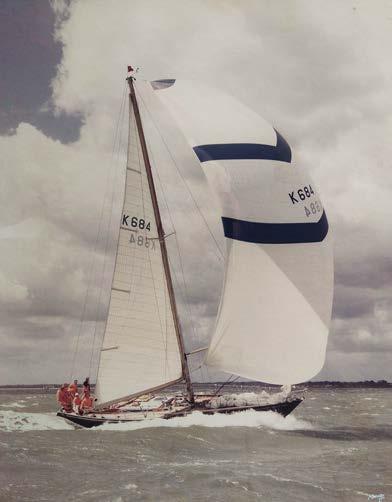
The following year Parr put Quailo on the market. By that time Camper & Nicholsons had built seven new Nicholson 55s for the Ministry of Defence – four for the navy, two for the army and one for the RAF – to replace the ageing Windfall Yachts as sail- training boats based at the Joint Services Sailing Centre in Gosport; and the navy’s Adventure had completed the Whitbread race in which she had come second overall (and may well have won it but for rudder damage). The MOD now bought Quailo to allocate to the army, renamed her British Soldier and painted her red. But she was subsequently again renamed – this time becoming Broadsword – so that she would be less conspicuously linked to the British armed forces at the time of the escalating Northern Ireland conflict. During the MOD’s ownership, the interior was modified by adding pilot berths outboard in the saloon, enlarging the galley and heads, and replacing 12 individual crew lockers with one large oilskin locker.
Broadsword served as an army sail-training boat until 2004 when she was sold to Ken Hudson, an Irish sheep farmer, who kept her in Arklow. During Hudson’s first year of ownership Broadsword took part in, but retired from, a particularly windy non-stop Round Ireland race, and she is thought to have subsequently crossed the Atlantic to the Caribbean and back. She was then sold to Jonathan Napier in 2011. While Napier was bringing her back to her new home in the Solent, her steering and engine gearbox failed, as a result of which
DESIGNED AND BUILT
LOA 14.7m (48ft)

BEAM 14ft 1in (4.3m)
DISP 23 tonnes
she had to be towed into Falmouth where repairs were carried out before the voyage was completed. Peter Farmery, by his own admission an inexperienced sailor at that time, was part of the delivery crew and, despite the problems along the way, he “fell in love” with the boat and he came to an agreement with Napier that they should be joint owners.
The two new owners were particularly keen to restore the boat to her original condition. This involved “removing much of the equipment and excessive deck fittings which the MOD had added,” said Farmery, painting her topsides in the original green colour of all the Quailos and, last but not least, renaming her Quailo III. They also replaced the two pipe cots in the forward cabin with wide, comfortable berths “to make it a nice cabin for a couple.”
During their ownership, Napier and Farmery cruised Quailo to Ireland, France and along the English south coast, and they took part in various RORC and Solent races, including Cowes Weeks and Round the Island Races.
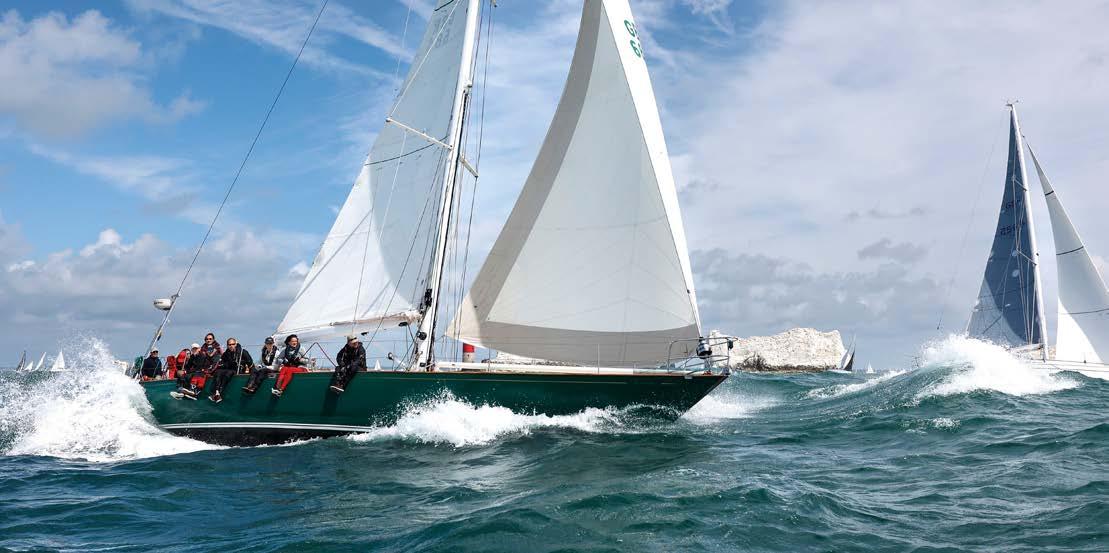
Andrew Tseng’s sailing career got off to a poor start. As an eight-year-old he sailed with his uncle in the USA “but spent most of the time below getting properly seasick,” he told me. He didn’t sail again for about 30 years but, in 2010, a friend who was about to do an RYA Day Skipper course suggested he should come along and do a Competent Crew course at the same time. Andrew did so and “kind of lapped it up. It reminded me of skiing, in that you are harnessing nature in the beauty of the outdoors.” He subsequently gained his own Day Skipper qualification and then became friends with some members of the London Business School Alumni Sailing Club with whom he raced and cruised on Sunsail yachts and a J109. Then he began to think about buying his own boat. “I think
I was looking for more of a project,” he said, “a boat that was a bit tired and had seen better days, which I could sympathetically modernise, create a wolf in sheep’s clothing.” Initially he looked into buying a 1980s Swan 53 but that fell through, then during an internet search he found Quailo III and thought “this is a very pretty boat.” Although he very much liked her when he viewed the boat, he was initially quite daunted at the thought of making the purchase. But when, several months later in early 2018, she was still on the market, he decided to take the plunge. He started racing Quailo straight away, and has taken part in the Round the Island Race every year that it has been held since, as well as various RORC races. One thing that soon became apparent was that her performance in light airs was disappointing. This issue has its roots in the RORC rating rule which was in force when the Nicholson 55s were built and which heavily penalised sail area. Although Quailo was originally given a mast height about 18in (45cm) taller than Lutine, she was still noticeably under-canvassed.
As a RORC committee member, Andrew is all too aware of the highly significant landmark of the Fastnet Race in 2025 – it will be the 100th anniversary of the first race and of the formation of the RORC – and he soon became fixated on the long-term target of taking part in that race. “But I wanted to make sure the boat would be reasonably competitive by then, so it would make sense for that not to be our first Fastnet,” he said. “So we would have to do the 2023 Fastnet –which will be the 50th race – and working back from then we would need to have a new rig a year or two before that to give us time to thoroughly tune it.”
Andrew brought in naval architect Paul Spooner to design the new rig. Lutine – now named Eager – had already been given a new taller masthead carbon rig.
Above: Kate Sawbridge on the helm, owner next to her in red jacket

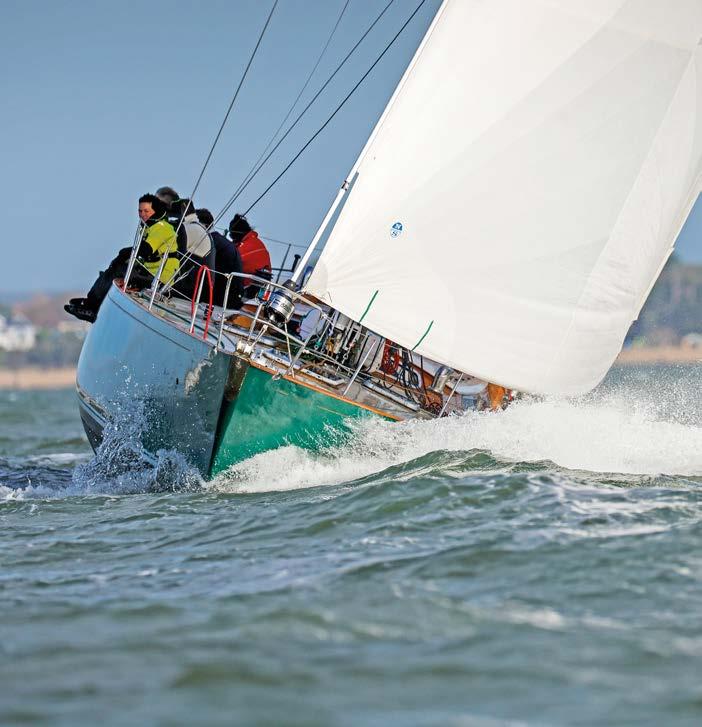

Left: The side cockpit seats have been raised to allow easier use of the winches
Right: Cowl vent
Below: Saloon looking to starboard (right) and looking forward (left). Saloon and galley areas will be reconfigured at some point in the future


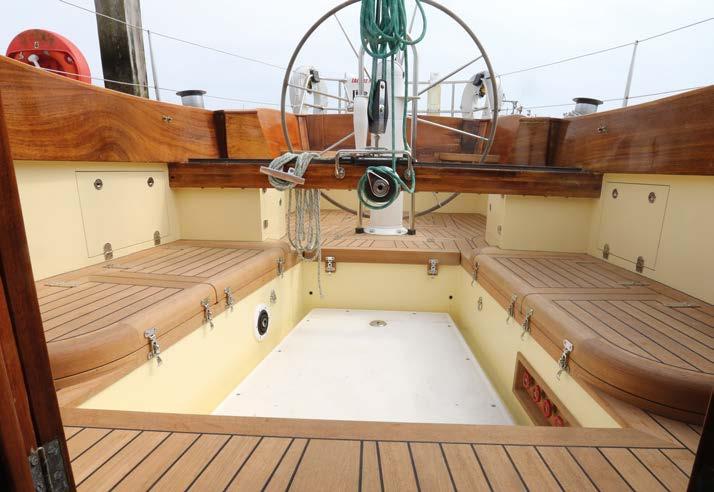
But for Quailo Paul drew a fractional rig 2.5m (8ft) higher than her original but with the foretriangle at the same height – partly because the current IRC rule penalises big headsails, but also to allow existing headsails to continue to be used – and with a boom 0.75m (2ft 6in) longer. The new carbon spars were made by Axxon Composites in Romania and have swept back spreaders and cap shrouds to avoid the need for high-dependency runners, although there is a pair of lower runners to ensure the inner forestay is tight when sailing as a cutter or with a storm jib. Quailo’s performance in light airs has now improved noticeably, but the next development will be to experiment with smaller headsails to replace the large overlapping ones. This will improve her rating and allow her to point higher, but whether her speed decreases disproportionately remains to be seen.

The cockpit has also received some attention. The plywood seat tops were in a poor state, so they have been remade with teak laid on top. Farmery and Napier had moved the primary winches from inside the coamings to the outside, but Andrew and his crew found they were a little too high for convenient winching when standing on the cockpit seats. To raise all of the seating area in the forward part of the cockpit would uncomfortably reduce the sitting headroom under the coachroof overhang (which extends aft about 0.5m/1ft 8in over the cockpit) so just the side locker lids have been raised, by nearly 100mm (4in). All the new cockpit work was carried out by Centreline Marine.
The first time Andrew and Paul Spooner handled Quailo under engine, it was very clear that she was underpowered and difficult to manoeuvre. The original engine was a 37hp Perkins, and Farmery and Napier had installed a 60hp Yanmar. Both engines were fitted under the cabin sole below the doghouse which gave very little useful prop wash over the rudder which was about 2m (6ft 6in) aft of the propellor. A Yanmar 110hp engine with a V-drive has now been installed below the cockpit, and this, along with a new Sidepower bowthruster, has greatly improved manoeuvrability. Furthermore, new fuel and water
tanks have been fitted, and a mild case of osmosis has been treated. All of the engineering and osmosis work was carried out by Osmotech, while Casse Tête Marine have undertaken general maintenance work to the topsides, deck and coachroof.
The new engine position will also contribute to Andrew’s long-term plans to reconfigure the interior. The main part of the accommodation between the companionway and the heads is on two levels: the upper part aft in which the galley is to port and the chart table and large oilskin locker are to starboard, and the lower part forward which includes the saloon seating and four pilot berths.
Andrew’s plan is to move the saloon seating to “the lovely space under doghouse to avoid sitting lower down in the depths” with the sole lowered to give sitting headroom under the side decks (which would not have been possible with an engine in the original location); to fit a new galley and a separate double cabin in the lower area; and to convert the forward cabin into a more comfortable double cabin. Although the design for the new layout is more-or-less finalised, the style is yet to be agreed but is likely to be sympathetic to Quailo’s original era. The interior conversion may not be done until after the 2025 Fastnet race but Andrew hopes that it will allow comfortable cruising over increasing distances, particularly with his wife Veronika and their toddler Arthur.
Just like Quailo’s first owner, Andrew “tries to run a happy crew” which, when racing, generally consists of friends from the London Business School Alumni SC and the RORC. “It is important that everyone enjoys the sailing and the companionship, and wants to share in the whole experience,” he said. A particularly satisfactory part of that experience, he finds, is the enthusiastic welcome that Quailo often gets from people who have previously sailed on Nicholson 55s, and in some cases on Quailo herself when she was with the MOD, although they are typically unaware initially that she is the same boat.
WORDS AND PHOTOGRAPHS NIGEL SHARP
Australia Day commemorates the anniversary of the date – 26 January 1788 – when Arthur Philip and the First Fleet arrived in what subsequently became known as Sydney Harbour. A sailing regatta has been held on the harbour to mark this occassion every single year since 1837 – albeit not always on the exact anniversary – and so is considered to be the oldest continuously conducted annual sailing regatta in the world. The regatta is by no means just one event, and this year more than 20 clubs across New South Wales ran various races including everything from an o shore race from Sydney to Botany Bay and back, to races for radio controlled model yachts. These photos show a race – organised by the Royal Sydney Yacht Squadron on Sydney Harbour – “not the Olympic Games but more of a picnic race,” according to John Jeremy, former commodore of the Sydney Amateurs Sailing Club.

